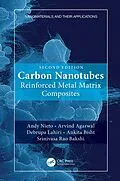This discovery of carbon nanotubes (CNT) three decades ago ushered in the technological era of nanotechnology. Among the most widely studied areas of CNT research is their use as structural reinforcements in composites. This book describes the development of CNT reinforced metal matrix composites (CNT-MMCs) over the last two decades. The field of CNT-MMCs is abundant in fundamental science, rich in engineering challenges and innovations and ripe for technological maturation and commercialization.
The authors have sought to present the current state of the-art in CNT-MMC technology from their synthesis to their myriad potential end-use applications. Specifically, topics explored include:
. Advantages, limitations, and evolution of processing techniques used to synthesize and fabricate CNT-MMCs
. Emphasizes dispersion techniques of CNTs in metallic systems, a key challenge to the successful and widespread implementation of CNT-MMCs. Methods for quantification and improved control of CNT distributions are presented
. Methods for quantification and improved control of CNT distributions are presented
. Characterization techniques uniquely suited for charactering these nanoscale materials and their many chemical and physical interactions with the metal matrix, including real-time in-situ characterization of deformation mechanisms
. Electron microscope images from premier studies enrich discussions on micro-mechanical modeling, interfacial design, mechanical behavior, and functional properties
. A chapter is dedicated to the emergence of dual reinforcement composites that seek to enhance the efficacy of CNTs and lead to material properties by design
This book highlights seminal findings in CNT-MMC research and includes several tables listing processing methods, associated CNT states, and resulting properties in order to aid the next generation of researchers in advancing the science and engineering of CNT-MMCs. In addition, a survey of the patent literature is presented in order to shed light on what the first wave of CNT-MMC commercialization may look like and the challenges that will have to be overcome, both technologically and commercially.
Autorentext
Andy Nieto is an Assistant Professor in the Department of Mechanical and Aerospace Engineering at the Naval Postgraduate School (NPS) in Monterey, California, USA.
Arvind Agarwal is a Distinguished University Professor and Chair of the Department of Mechanical and Materials Engineering at Florida International University (FIU), Miami, FL, USA.
Debrupa Lahiri is an Associate Professor in the Department of Metallurgical and Materials Engineering, IIT Roorkee, India.
Ankita Bisht is an Assistant Professor in the Department of Mechanical Engineering, Women Institute of Technology (WIT), Dehradun, India.
Srinivasa Rao Bakshi is an Associate Professor in the Department of Metallurgical and Materials Engineering at India Institute of Technology Madras, India.
Inhalt
1. Introduction 1.1 Composite Materials 1.2 Development of Carbon Fibers 1.3 Carbon Nanotubes: Synthesis and Properties 1.4 Carbon Nanotube - Metal Matrix Composites (CNT-MMCs) 1.5 Chapter Highlights References
2. Dispersion of Carbon Nanotubes in the Metal Matrix 2.1 Significance of Carbon Nanotube Dispersion 2.2 Methods for Carbon Nanotube Dispersion 2.3 Quantification of Carbon Nanotube Dispersion 2.4 Chapter Highlights References
3. Composite Processing Techniques 3.1 Powder Metallurgy Routes 3.2 Melt Processing 3.3 Thermal Spraying 3.4 Electrochemical Routes 3.5 Novel Techniques 3.6 Conclusion 3.7 Chapter Highlights References
4. Characterization Technique for CNT-MMC Materials 4.1 X-Ray Diffraction 4.2 Raman Spectroscopy 4.3 Scanning Electron Microscopy with Energy Dispersive Spectroscopy 4.4 High Resolution Transmission Electron Microscopy 4.5 Electron Energy Loss Spectroscopy 4.6 X-Ray Photoelectron Spectroscopy 4.7 Mechanical Properties Evaluation 4.8 Thermal Properties 4.9 Electrical Properties 4.10 Electrochemical Properties 4.11 Chapter Highlights References
5. Carbon Nanotube Reinforced Metal Matrix Composite (CNT-MMC) Systems 5.1 Aluminum-Carbon Nanotube System 5.2 Copper-Carbon Nanotube System 5.3 Nickel-Carbon Nanotube System 5.4 Magnesium-Carbon Nanotube System 5.5 CNT-MMC Foams 5.6 CNT-Metal Nanolaminates 5.7 Other Metal-Carbon Nanotube Systems 5.8 Chapter Highlights References
6. Mechanics of CNT-MMCs 6.1 Elastic Modulus of Metal Matrix-Carbon Nanotube Composites 6.2 Strengthening Mechanisms in Metal Matrix-Carbon Nanotube Composites 6.3 Chapter Highlights References
7. Interfacial Phenomena in CNT-MMCs 7.1 Significance of Interfacial Phenomena 7.2 Energetics of Carbon Nanotube-Metal Interaction 7.3 Carbon Nanotube-Metal Interaction in Various Systems 7.4 Incorporation of Interphases 7.5 Chapter Highlights References
8. Tribological, Transport, and Functional Properties & Behavior 8.1 Tribological Properties 8.2 Thermal Properties 8.3 Elevated Temperature Mechanical Behavior 8.4 Electrical Properties 8.5 Corrosion Properties 8.6 Hydrogen Storage 8.7 Sensors and Catalytic Properties 8.8 Chapter Highlights References
9. Synergistic Interactions of CNT with Secondary Reinforcements 9.1 Ceramic Particle-CNT Dual Reinforcement 9.2 Nanocarbon-CNT Dual Reinforcement 9.3 Chapter Highlights References
10. Computational Studies in CNT-MMCs 10.1 Overview of Early Computational Studies on CNT-MMCs 10.2 Thermodynamic Prediction of Carbon Nanotube-Metal Interface 10.3 Microstructural Simulation 10.4 Mechanical and Thermal Property Prediction by the Object-Oriented Finite Element Method 10.5 Chapter Highlights References
11. Patents and Commercialization 11.1 Patents 11.2 Prospects & Challenges for Commercialization 11.3 Chapter Highlights References
12. Summary and Future Directions 12.1 Summary of CNT-MMC Research 12.2 Future Directions References
